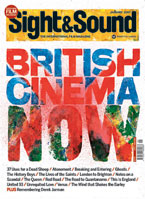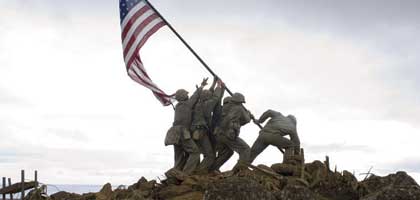Primary navigation

USA 2006

Reviewed by Ali Jaafar
Our synopses give away the plot in full, including surprise twists.
Iwo Jima, 1945. US forces prepare to take the Pacific island of Iwo Jima from 20,000 Japanese soldiers. As they land, a fearsome battle ensues. On the fifth day of the assault, US forces have succeeded in partially pushing back the Japanese. American colonel Chandler Johnson orders his soldiers to raise the US flag on Mount Suribachi to help lift troop morale. The colonel's superior requests the flag as a souvenir for his office; Johnson sends six other men to raise another flag. Press photographer Joe Rosenthal happens to capture the moment. His image is a sensation in America and is reprinted on the front page of every newspaper. The government decides to bring back the three surviving soldiers in the photo to embark on a war-bond selling PR exercise. Now back in America, John Bradley, Rene Gagnon and Ira Hayes struggle to come to terms with their fame and the endless nationwide publicity junket. Hayes, increasingly dependent on alcohol, requests to be sent back to the front line as all three men eventually go their separate ways. Years later, Hayes dies of exposure back in America, while John Bradley dies peacefully of old age in a hospital bed after telling his son he loves him.
The opening scene of Flags of Our Fathers thrusts the viewer straight into the heart of hell. Dazed US serviceman John 'Doc' Bradley stumbles around the blackened sands of the volcanic Pacific island Iwo Jima, incomprehension and dread clouding his face. "Every jackass thinks he knows what war is," murmurs the voiceover before the film cuts forward to that same Bradley, now an elderly man close to death, the ghosts of the battlefield haunting him still. Far from a straight recreation of the horrors of war, however, Clint Eastwood's film, adapted from the book of the same name by James (son of Doc) Bradley, is more concerned with the malleability of truth and memory. It tells the story of the six American soldiers famously photographed raising the US flag on Iwo Jima's Mount Suribachi during the US-Japanese battle for the island, the deadliest engagement in the history of the US Marines.
Reprinted on the front page of every American newspaper, Associated Press photographer Joe Rosenthal's near-accidental snapshot helped re-energise a US war effort that by 1945, the film underlines, was close to financial bankruptcy. Rather than buy into any sense of rah-rah jingoism, Eastwood focuses instead on the political establishment's exploitation of the three surviving soldiers from the photograph as they are withdrawn to the home front and sent on a war-bond selling PR tour. The mission is the money as Bradley, Rene Gagnon and Ira Hayes shake hands and play misty for the camera. The publicity stunts become ever more absurd, and involve ice-cream sculptures of the flag being raised and the trio recreating the incident in a stadium full of adoring football fans.
Not that the 76-year-old director shies away from the brutal reality of combat. Comparisons to Steven Spielberg's bloody staging of the Normandy landings in Saving Private Ryan are inevitable (Spielberg is Eastwood's co-producer on this film), but Eastwood takes that film's desaturated look a step further, bleaching his stock to a virtual monochrome. What emerges is a sulphuric wasteland of dismembered limbs and smoking human carcasses, a stark contrast to the vast US military and naval operation surrounding the island that Eastwood occasionally pans away to.
A more apt reference point may be Eastwood's own Unforgiven (1992). Returning to the strand of iconoclastic myth-debunking that coursed through that guilt-laden Western, Eastwood questions the very nature of heroism. We discover, for example, that the six soldiers immortalised in Rosenthal's image were only called upon after a souvenir-hungry officer had requested the flag raised by a different set of troops earlier in the day for his office wall.
More importantly, given current events, the idea of propaganda in swaying an uneasy public is given an intellectual runout. "The right picture can win or lose a war," says one veteran. Though the infamous 1968 photograph of South Vietnamese police officer Nguyen Ngoc Loan executing a suspected Vietcong prisoner is mentioned, surely more pressing in contemporary audiences' minds will be the shocking images of Iraqi prisoners being abused in Abu Ghraib and of the blindfolded, jumpsuit-clad inmates of Guantánamo Bay. It is a dexterous sleight of hand on Eastwood's part that he simultaneously commemorates the dignified humanity of the three servicemen while excoriating the bluster of those in command on all sides (Eastwood is currently completing a companion piece Letters from Iwo Jima, which will show the same events from a Japanese perspective).
And while Eastwood reserves generous praise for America's so-called "greatest generation", there is an indication of the domestic battles ahead. Most poignant of all is the plight of the whisky-soaked Native American Hayes, previously portrayed by Tony Curtis in 1961's The Outsider. Hayes emerges as the film's most tragic figure, thanks in large part to a mournful performance from Adam Beach. Unable to reconcile his new-found status as nation's favourite son with his still being refused entry to bars on grounds of race and being mockingly referred to as "chief", Hayes is a reminder of the absence at home of those same liberties he was sent overseas to defend.
It is a shame, therefore, that Eastwood allows his final act to become bogged down by tedious exposition about the post-war fate of the three central characters. Most irrelevant of all is a resolution to the Bradley father-son relationship. The prominence of the voiceover in this weakest section is particularly jarring given the lasting power of Rosenthal's image. In the photograph the soldiers are faceless, representing an abstract symbol of brothers in arms that transcends literalism. While Eastwood succeeds in reclaiming the fact from the legend in Flags of Our Fathers, he does so at the risk of diluting his film's undeniable moments of visceral power. "Heroes are something we create, something we need," says the voiceover during the final scene. It's a fitting epitaph for Eastwood himself, maybe America's last grand old man of wild frontiers. Perhaps, in the ultimate act of self-deprecation, it is that very notion he is trying to shoot down.